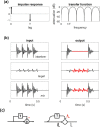Harmonic Cancellation-A Fundamental of Auditory Scene Analysis
- PMID: 34698574
- PMCID: PMC8552394
- DOI: 10.1177/23312165211041422
Harmonic Cancellation-A Fundamental of Auditory Scene Analysis
Abstract
This paper reviews the hypothesis of harmonic cancellation according to which an interfering sound is suppressed or canceled on the basis of its harmonicity (or periodicity in the time domain) for the purpose of Auditory Scene Analysis. It defines the concept, discusses theoretical arguments in its favor, and reviews experimental results that support it, or not. If correct, the hypothesis may draw on time-domain processing of temporally accurate neural representations within the brainstem, as required also by the classic equalization-cancellation model of binaural unmasking. The hypothesis predicts that a target sound corrupted by interference will be easier to hear if the interference is harmonic than inharmonic, all else being equal. This prediction is borne out in a number of behavioral studies, but not all. The paper reviews those results, with the aim to understand the inconsistencies and come up with a reliable conclusion for, or against, the hypothesis of harmonic cancellation within the auditory system.
Keywords: auditory scene analysis; harmonic cancellation; harmonicity; pitch perception; segregation.
Conflict of interest statement
Figures







Similar articles
-
Identification of concurrent harmonic and inharmonic vowels: a test of the theory of harmonic cancellation and enhancement.J Acoust Soc Am. 1995 Jun;97(6):3736-48. doi: 10.1121/1.412389. J Acoust Soc Am. 1995. PMID: 7790652
-
No evidence for a benefit from masker harmonicity in the perception of speech in noise.J Acoust Soc Am. 2023 Feb;153(2):1064. doi: 10.1121/10.0017065. J Acoust Soc Am. 2023. PMID: 36859153
-
Harmonicity aids hearing in noise.Atten Percept Psychophys. 2022 Apr;84(3):1016-1042. doi: 10.3758/s13414-021-02376-0. Epub 2022 Jan 31. Atten Percept Psychophys. 2022. PMID: 35102502 Free PMC article.
-
Neural correlates of concurrent sound perception: A review and guidelines for future research.Brain Cogn. 2022 Nov;163:105914. doi: 10.1016/j.bandc.2022.105914. Epub 2022 Sep 22. Brain Cogn. 2022. PMID: 36155348 Review.
-
How We Hear: The Perception and Neural Coding of Sound.Annu Rev Psychol. 2018 Jan 4;69:27-50. doi: 10.1146/annurev-psych-122216-011635. Epub 2017 Oct 16. Annu Rev Psychol. 2018. PMID: 29035691 Free PMC article. Review.
Cited by
-
A unitary model of auditory frequency change perception.PLoS Comput Biol. 2023 Jan 12;19(1):e1010307. doi: 10.1371/journal.pcbi.1010307. eCollection 2023 Jan. PLoS Comput Biol. 2023. PMID: 36634121 Free PMC article.
-
Cellular and synaptic specializations for sub-millisecond precision in the mammalian auditory brainstem.Front Cell Neurosci. 2025 May 19;19:1568506. doi: 10.3389/fncel.2025.1568506. eCollection 2025. Front Cell Neurosci. 2025. PMID: 40458470 Free PMC article. Review.
-
Testing the role of temporal coherence on speech intelligibility with noise and single-talker maskers.J Acoust Soc Am. 2024 Nov 1;156(5):3285-3297. doi: 10.1121/10.0034420. J Acoust Soc Am. 2024. PMID: 39545746
-
The role of harmonicity on listeners' ability to hear out voices in polyphonic music.Sci Rep. 2025 Aug 28;15(1):31686. doi: 10.1038/s41598-025-16404-8. Sci Rep. 2025. PMID: 40877328 Free PMC article.
-
Mammalian octopus cells are direction selective to frequency sweeps by excitatory synaptic sequence detection.Proc Natl Acad Sci U S A. 2022 Nov;119(44):e2203748119. doi: 10.1073/pnas.2203748119. Epub 2022 Oct 24. Proc Natl Acad Sci U S A. 2022. PMID: 36279465 Free PMC article.
References
-
- al Haytham I. 1030. (2002) Book of optics (in Hatfield).
-
- Arehart K. H., Rossi-Katz J., Swensson-Prutsman J. (2005). Double-vowel perception in listeners with Cochlear hearing loss: differences in fundamental frequency, ear of presentation, and relative amplitude. Journal of Speech, Language, and Hearing Research, 48, 236–252. 10.1044/1092-4388(2005/017) - DOI - PubMed
Publication types
LinkOut - more resources
Full Text Sources

